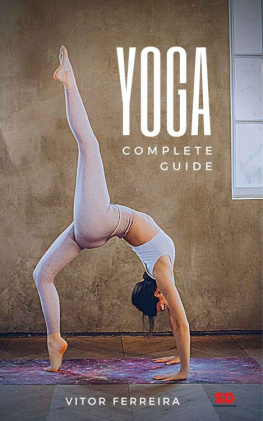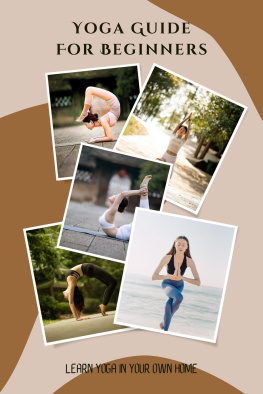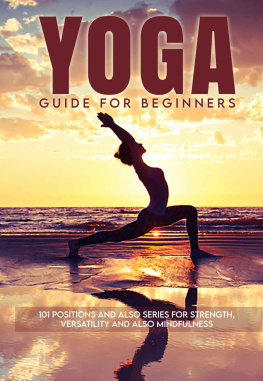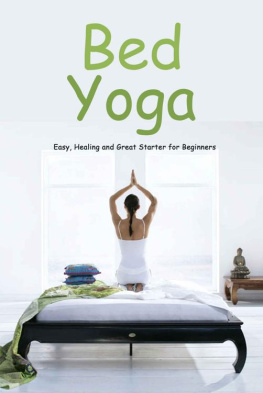Yoga Guide for Beginners
101 Poses and Sequences for Strength, Flexibility and Mindfulness
Melody White
Copyrights
All rights reserved 2018 by Melody White. No part of this publication or the information in it may be quoted from or reproduced in any form by means such as printing, scanning, photocopying, or otherwise without prior written permission of the copyright holder.
Disclaimer and Terms of Use
Effort has been made to ensure that the information in this book is accurate and complete. However, the author and the publisher do not warrant the accuracy of the information, text, and graphics contained within the book due to the rapidly changing nature of science, research, known and unknown facts, and internet. The author and the publisher do not hold any responsibility for errors, omissions, or contrary interpretation of the subject matter herein. This book is presented solely for motivational and informational purposes only.
Contents
Yoga for Beginners
What is Yoga
Hello and welcome! This book is targeted at beginner yoga practitioners. Theyre known as yogis (from the Classical Sanskrit word yogin ). A yogi can be male or female. The term for a female yoga practitioner is yogini, but it is not widely used.
Broadly speaking, yoga refers to a collection of practices for body, mind, and soul which originated in ancient India. Etymologically, yoga stems from the Sanskrit root yuj which means to add or to unite.
Essentially, yoga is more than physical exercise. It is a meditative practice with a spiritual core. Through its practice, yogis seek to reach the moksha , liberation. This liberation refers to breaking out of the cycle of death and rebirth. It means liberating ourselves from ignorance.
The precise definition of the term yoga varies with the context, but most of the time it refers to:
- A disciplined method of achieving a goal
- A set of techniques to control both mind and body
- A school of philosophy
- In conjunction with other prefixes, a traditional set of techniques and philosophies (yoga schools)
- The practice of yoga
Yoga involves static principles that vary slightly from one school to another while maintaining the same ultimate purpose: the liberation.
This refers to yoga as a means of discovering the dysfunctions in our perception and cognition. Through yoga, we overcome these to liberate ourselves from suffering, bringing forth inner peace and salvation.
By meditating with yoga, we raise and expand our consciousness. We change the lens to become coextensively aware with all that surrounds us and not just ourselves.
Yogis must carve a path to omniscience and heightened consciousness with yoga. The end goal is breaking our chains to falsehood and suffering. We are meant to understand both the impermanent and permanent realities that clash in life.
Please note that in case you are pregnant, nursing, have sustained injuries or have any other condition that might conflict with you practicing yoga, its important to consult the appropriate health services first before starting with yoga.
About Yoga Schools and Hatha Yoga
It is important to understand that all yoga schools stem from classical yoga, which is considered one of the stika (Sanskrit word for there it is or exists) schools of Hinduism.
In effect, yoga refers to a variety of schools with their own practices, methods, and philosophies extending to different Jain, Buddhist, and Hindu practices.
Amongst these Hindu schools, we can find Jnana yoga, Karma yoga, Bhakti yoga, and Hatha yoga, among others.
Hatha yoga (Hatha being the Sanskrit word for force) focuses on exercises to cultivate strength both physical and mental. The exercises in question are none other than the poses adopted in yoga, called asanas (the Sanskrit word for sitting down or to sit down).
For this reason, this book will focus on Hatha yoga. While other yoga schools do have the asanas as well, Hatha yoga is focused on mastering the body through them.
Hatha yoga is about using diet to purify our body, pranayama (breathing techniques) to master our life energy, and the asanas to master our physical abilities, obtaining the siddhis (special body powers) in the process.
Traditionally speaking, there are a few rules for performing the asanas:
- Asanas should be performed while fasting.
- Force should not be applied. The body should not tremble.
- The parts of the body should be moved slowly, particularly the head and heels.
- The breathing should be controlled (referred to as pranayama , the Sanskrit word for breath control or control of the breath; more about it later).
- Stress from the body should be released with special poses before performing other asanas.
Following these traditional rules, while not mandatory, can be very helpful for any prospective yogi.
It would be wise to remember that practicing yoga should be comfortable regardless of your skill level. You shouldn't push your body into discomfort at any point. Try your best not to turn yoga into a competition with yourself.
The goal here is mastering your body. Beginners wont feel too comfortable at the start; it will take several short sessions with relatively simple poses. As the yogi advances, he or she becomes unattached from the feeling of discomfort.
This is vital to reach the spiritual goal of yoga, which is detachment from suffering.
Besides the asanas, Hatha yoga extends to other practices. The philosophy behind it states that a successful yogi should display the following characteristics:
- Utsaha (enthusiasm or fortitude)
- Sahasa (courage or optimism)
- Dhairya (patience or persistence)
- Jnana Tattva (knowledge)
- Nishcaya (resolve or determination)
- Tyaga (solitude or renunciation)
Its easy for westerners to assume that Hatha yoga (or even yoga in general) is exclusively about the asanas.
Despite this mistaken conception, Hatha yoga encompasses more than that. It blends different ideas such as ethics, diet, cleansing, breathing and physical exercises, meditation, and spiritual development.
Consequently, to be a proper yogi one should reflect on the following practices:
Proper Diet
Special emphasis is given to mitahara (the Sanskrit word that translates to habit of moderate food). It consists of a heightened awareness about food, drink, diet, and consumption habits.
Ancient texts refer to mitahara as a concept that links proper nutrition with the health of the body and mind. Some of the largest nutrition compendiums that have survived from ancient India highlight the importance of planning a diet.
The Charaka Samhita (Compendium of Charaka) states that wholesome diets promote health and growth. This concept, while coming from a collection of books that date from the pre-2nd century CE, is in perfect accord with modern thinking.
The general idea of mitahara is that we should tailor our diet according to our body, health, climate, season, habits, and tastes as well as constantly rotating what we eat to avoid excesses.
Proper body cleansing
This refers to a series of practices to cleanse the body with the help of a yoga teacher.
These are beyond the scope of this book. However, I will briefly list them here in case you are curious:
Net
Yogic system for the cleaning of our air passageways. In simpler words, nasal wash with purified water and non-iodized salt.
This practice is wonderful for those who suffer nasal problems, but it should be performed with the aid of an expert and only after proper medical examination.
Dhaut
Yogic system of body cleansing techniques. This practice is directed to the cleaning of the digestive and respiratory tracts, and the external ears and eyes.
Next page







